Shoyuzuke or Soy Sauce Pickling is one of the easiest tsukemono (Japanese pickles) you can make at home! Preserve fresh seasonal vegetables and serve them as a palate cleanser in your Japanese meal.
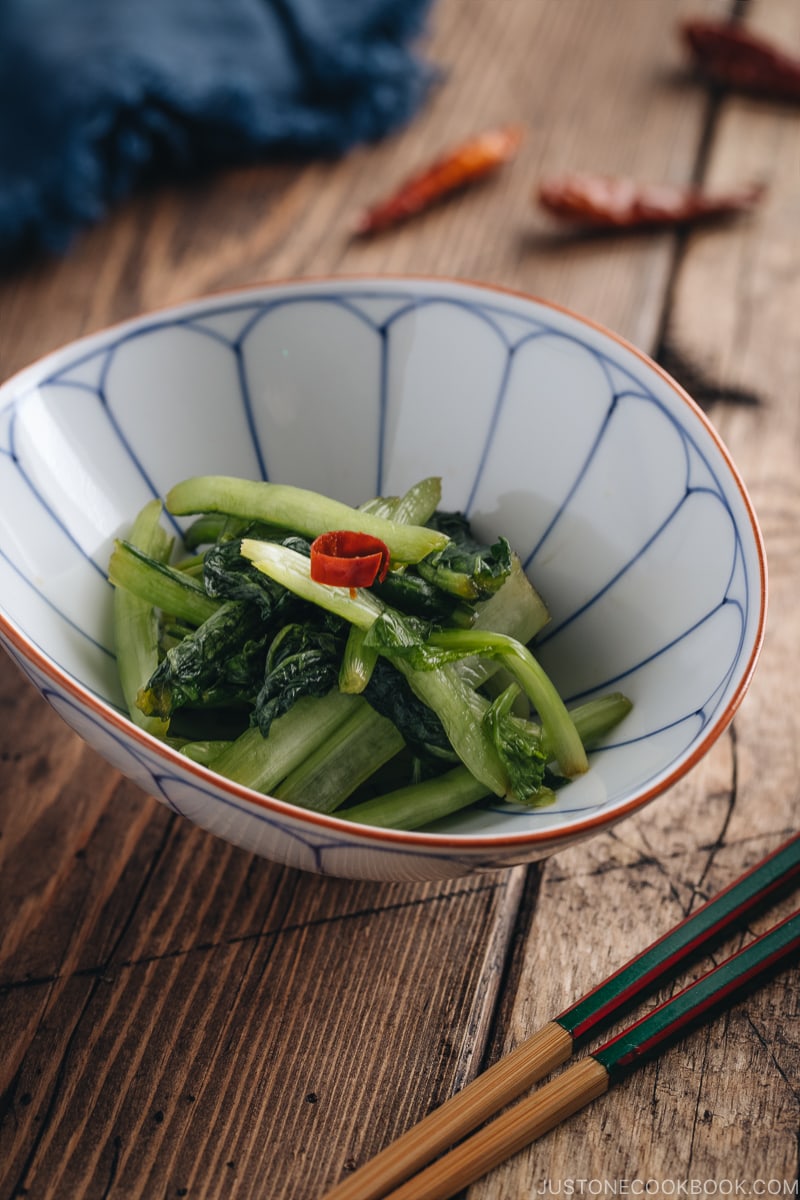
Pickling may come across as a tedious undertaking for beginners, but you’ll be surprised how easy it is once you give it a try. In the world of Japanese pickles, you can start out by experimenting with one of the simplest pickling methods called shoyuzuke (醤油漬け).
Shoyuzuke refers to soy sauce (shoyu) pickling (zuke). It is a very basic form of pickles in Japanese cuisine known collectively as tsukemono (漬物). For today’s recipe, I’ll show you how to pickle Japanese mustard or komatsuna for a refreshing side dish to your meal.
Table of Contents
What is Tsukemono?
Tsukemono (漬物), or Japanese pickles, are a classic side dish in a traditional Japanese meal. Some popular ones you may be familiar with include takuan (pickled daikon), umeboshi (pickled plum), gari (pickled sushi ginger), and fukujinzuke, the Japanese curry rice condiment.
Pickles are used to cleanse the palate between courses, such as pickled ginger in a sushi dinner. They help to preserve other foods, like a pickled plum tucked into a rice ball to help preserve the rice. Pickles that have a crunchy texture also provide a textural contrast to any meal.
There are several types of tsukemono based on the pickling agent:
- Shiozuke (塩漬け) – salt
- Suzuke (酢漬け) – vinegar
- Amazuzuke (甘酢漬け) – sugar and vinegar
- Misozuke (味噌漬け) – miso paste
- Shoyuzuke (醤油漬け) – soy sauce
- Kasuzuke (粕漬け) – sake kasu (sake lees)
- Shiokojizuke (塩麹) – rice koji/mold-cultured rice
- Nukazuke (糠漬け) – nuka (rice bran)
- Karashizuke (からし漬け) – Japanese hot mustard karashi
- Satozuke (砂糖漬け) – sugar
Today, let’s talk about shoyuzuke. If you’re interested in learning more about different types of tsukemono, read Tsukemono: A Guide to Japanese Pickles on my blog.
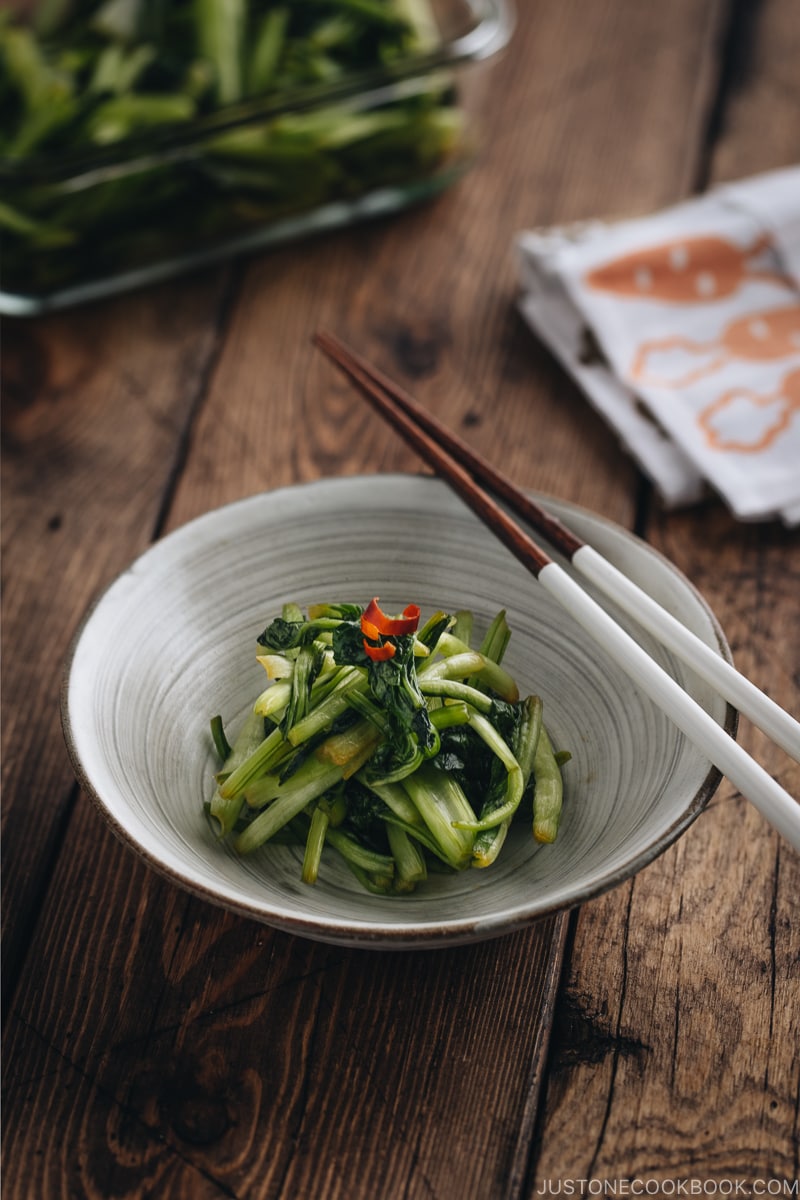
What is Shoyuzuke?
Shoyuzuke (醤油漬け) is pickling with a soy sauce-based agent. It also refers the food pickled in a soy sauce base. The basic shoyuzuke pickling agent is very easy to make. You just need to make a mixture of soy sauce, rice vinegar, and sugar.
Ready in a few hours of fermenting time, shoyuzuke is a popular choice for preserving vegetables. The pickled vegetables are eaten as they are (raw) and keep for up to a week in the refrigerator.
Ingredients for Today’s Recipe
There are many vegetables and flavors you can use in your shoyuzuke. Today, I’ll demonstrate how to make shoyuzuke using komatsuna (Japanese mustard spinach) using the following ingredients:
- Japanese mustard spinach (komatsuna 小松菜) – or substitute your favorite leafy green vegetable
- dried red chili pepper – optional
- soy sauce
- rice vinegar (unseasoned)
- sugar
How To Make Shoyuzuke
- Weigh the komatsuna. Prepare a heavy object that’s 1½–2 times the komatsuna’s weight.
- Cut the komatsuna in shorter pieces. Chop the red chili pepper into smaller pieces.
- Combine the greens, sugar, soy sauce, rice vinegar, and chili pepper in a 1-gallon glass jar or other container. Mix well with your hands.
- Place a flat plate with the weight on top of the greens. I used a mason jar filled with water for my heavy object. Close the lid.
- Let sit for 6 hours at room temperature.
- Squeeze the liquid out and serve. Store the shoyuzuke in an airtight container in the fridge for up to a week.
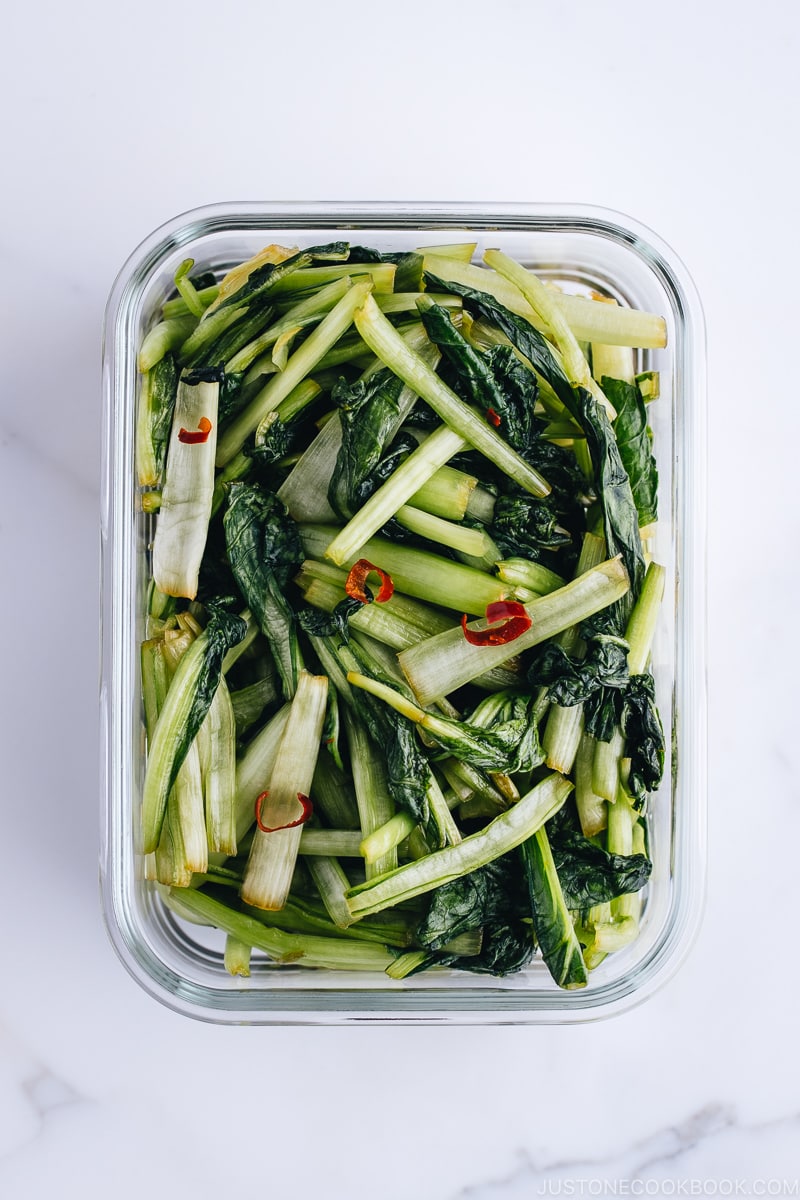
Variations and Substitutions
Read on to learn about the different vegetable and flavor possibilities for shoyuzuke!
Other Vegetables for Shoyuzuke
Feel free to preserve these other common vegetables using soy sauce pickling:
- Japanese turnip (kabu カブ)
- daikon radish (Japanese radish)
- cucumber
- eggplant
- celery
- cabbage
- broccoli rabe
- root vegetables like renkon (lotus root) and gobo (burdock root)
For high-moisture vegetables, be sure to extract the excess liquid prior to pickling. This prevents mold growth and dilution of the pickling liquid. This applies to veggies with a high-water content like daikon and cucumber.
Sprinkle the vegetable with salt roughly 5% of the weight of the vegetable. Leave it for 15 minutes. Quickly rinse under water and squeeze the liquid out (or pat dry with a towel).
Optional Flavor Boosters
Change up your shoyuzuke by add any of the following ingredients to your basic brine to add a boost of flavor:
- red chili pepper
- dashi
- mirin
- grated ginger
- myoga ginger
- julienned shiso
- garlic
- sesame seeds
What To Serve with Shoyuzuke
Just like shiozuke and misozuke, shoyuzuke is definitely one of the easiest ways to enjoy vegetables. For a quick dinner, I often serve these pickled vegetables as a side with steamed rice and miso soup and I’d add a protein dish like Miso Cod or Chicken Tempura. I also love adding the pickled vegetables on Ochazuke for a quick, simple, and healthy snack.
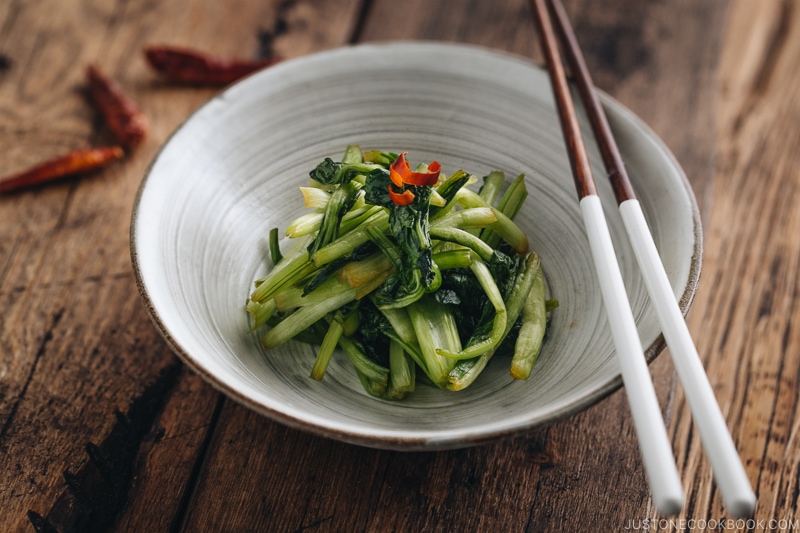
Other Shoyuzuke Recipes You’ll Love
Wish to learn more about Japanese cooking? Sign up for our free newsletter to receive cooking tips & recipe updates! And stay in touch with me on Facebook, Pinterest, YouTube, and Instagram.
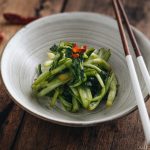
Tsukemono – Shoyuzuke (Soy Sauce Pickling)
Ingredients
- 1 lb Komatsuna (or any leafy greens)
- 1 red chili pepper
For the Pickling Solution
- 2 Tbsp sugar
- ¼ cup soy sauce
- 1½ Tbsp rice vinegar (unseasoned)
Instructions
- Gather all the ingredients. Important: Measure the weight of the vegetables. You will need a heavy object (and a plate) that‘s 1½–2 times the weight of the vegetables.
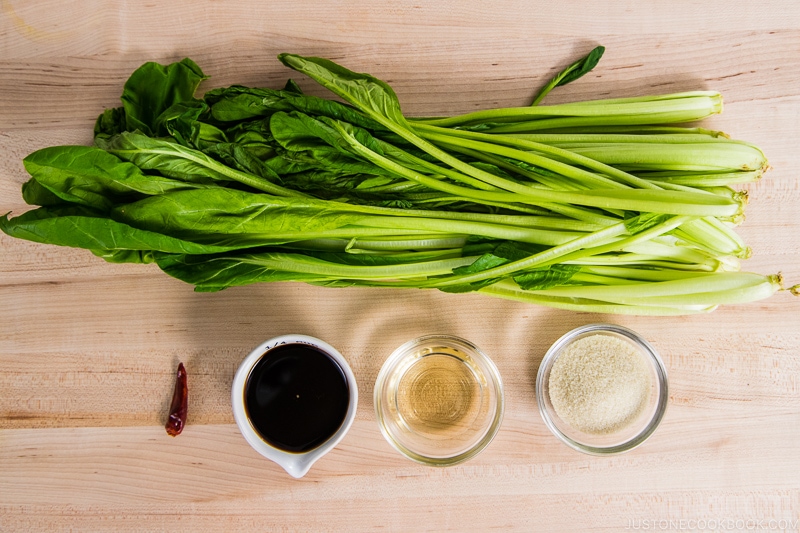
- Cut 1 lb Komatsuna into 2-inch (5-cm) pieces. Chop 1 red chili pepper into smaller pieces. If you want mild spiciness, discard the seeds.
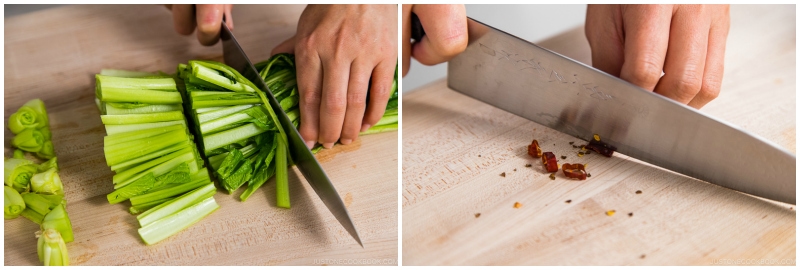
- Add the greens to a 1-gallon glass jar (or any big container).
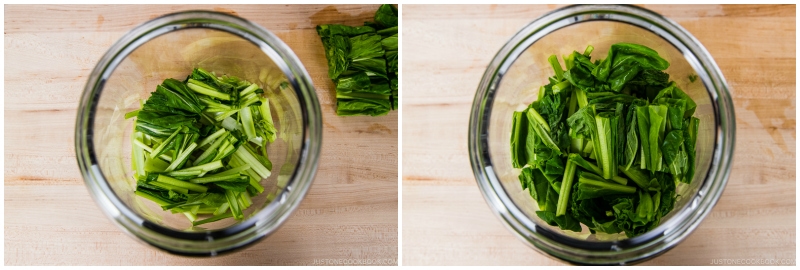
- Add the chopped red chili pepper, 2 Tbsp sugar, ¼ cup soy sauce, 1½ Tbsp rice vinegar (unseasoned).
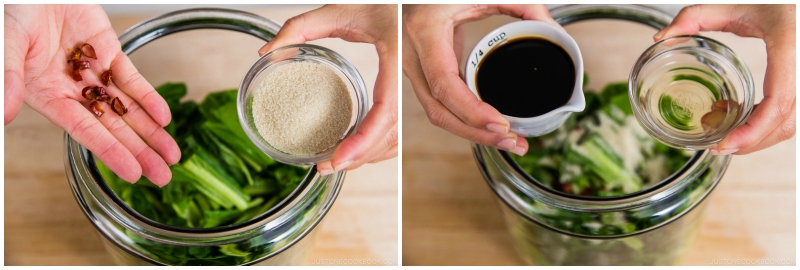
- WIth your hands (covered with plastic gloves), mix everything together well.
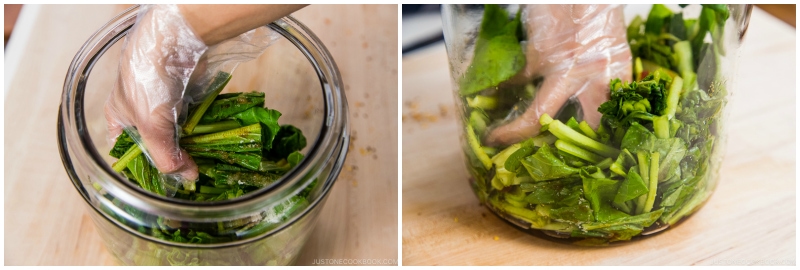
- Place a flat plate on top of the greens and then put a weight (1½–2 times the weight of the vegetables) on top of the plate. I used a mason jar filled with water.
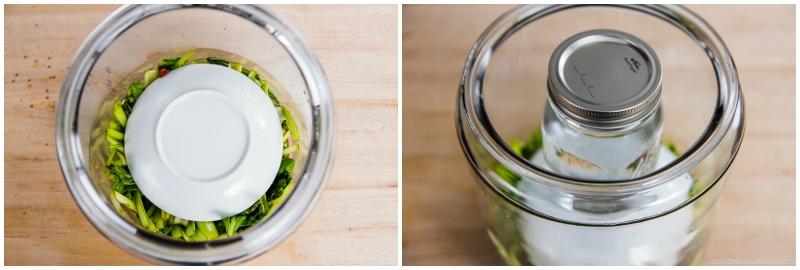
- Close the lid (or cover with plastic wrap) and set aside at room temperature for 6 hours.
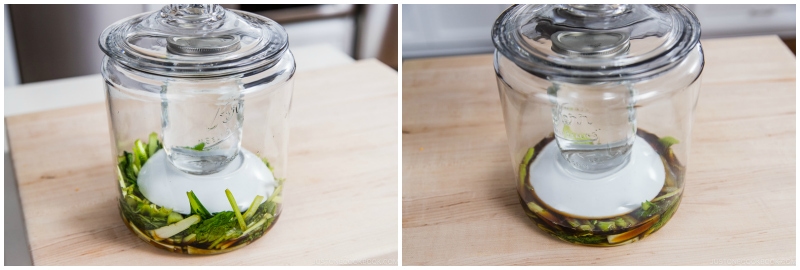
- The image shows the pickles after 6 hours. The greens are completely submerged in the liquid.
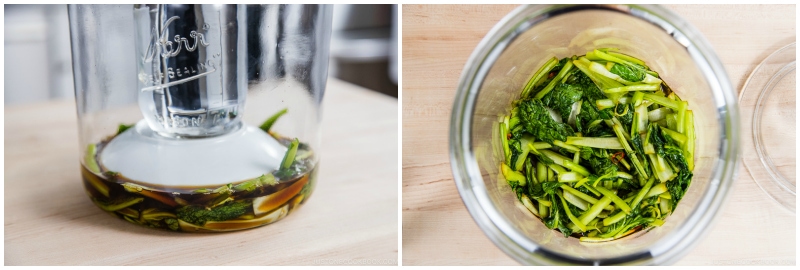
- Squeeze the liquid out and transfer it to an airtight container. Enjoy.
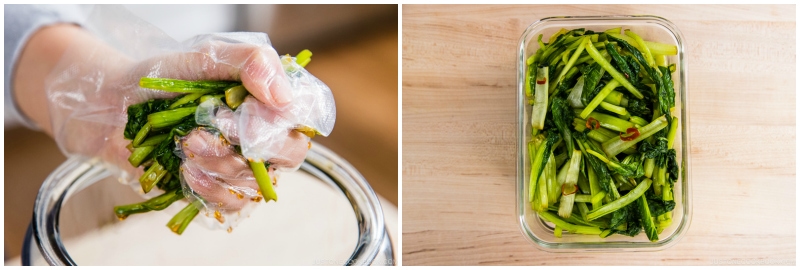
To Store
- Store the shoyuzuke in the refrigerator for up to a week.
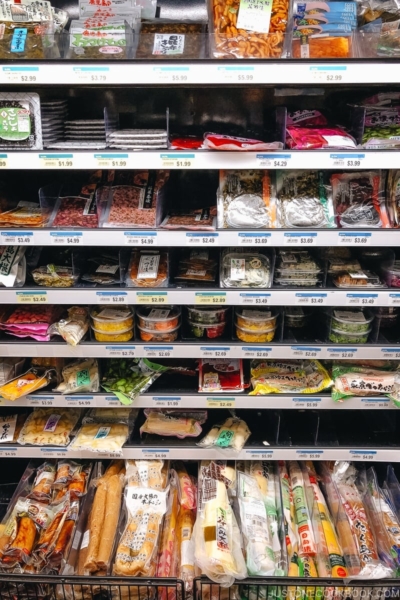
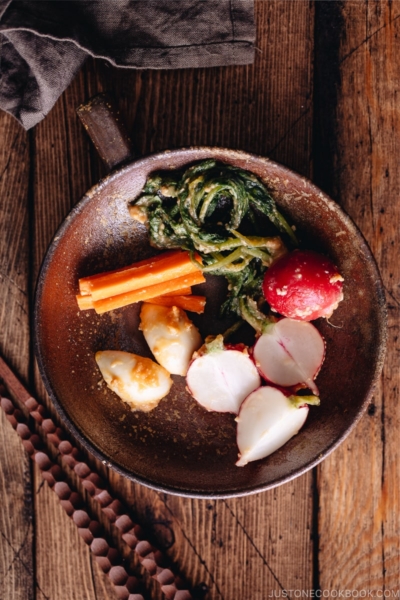
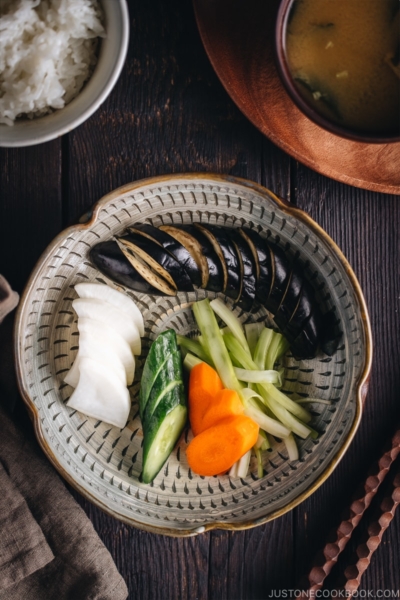
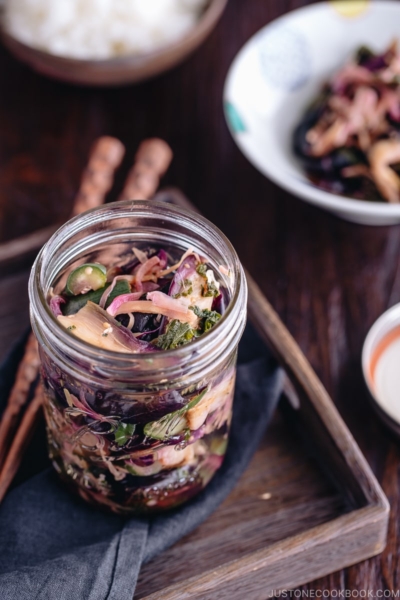




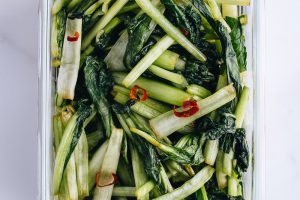
What is the ratio of soy sauce to sugar to rice vinegar?
Hello, Irene. Thank you for trying Nami’s recipe.
The ratio of soy sauce, sugar, and rice vinegar will be 2:1:0.75.
We hope this helped!
This is a really great recipe and I’ve been using it for a while now. Thank you for sharing it! A few enhancements: A) It’s almost always ideal in my opinion to add a bit of allium to the mix; sliced scallions, negi, or even just some normal very thinly sliced white onion tastes great. B) Also, I like some herbs. Shiso or basil are both nice; but recently I had some mint on hand and used that and it gave a very nice refreshing flavor. C) Finally, I like to add 1/2 tsp of MSG to the seasoning to make things pop a bit more.
As for the leftover brine, I’ve been putting that to good use as well: Bring it to a simmer on the stove for a couple of minutes and the leftover plant matter will congeal/coagulate on top. Once that happens, pass it through a coffee filter. Now put it back on the stove and simmer until it gets to about 1/4 of its original volume. You’ll be left with a thick and delicious sauce that tastes amazing, especially with grilled food.
Hello there, Adam! Thank you very much for trying Nami’s recipe and sharing your cooking experience and advice with us!😊
Should the veggies be pickled at room temperature (from the recipe) or in the fridge (from the notes).
Hi Zita, Thank you for trying Nami’s recipe.
To make/pickle, please set aside at room temperature for 6 hours. When you’re finished, please squeeze the liquid and store it in the refrigerator.
We hope this helps!
Every year for Oscar nights, I make a dish for each best picture nominee. For Drive My Car, it’s an array of Japanese pickles. I made this recipe, and I’m blown away with how good it is. Thank you! (also have the misozuke going, and will do some of the salt pickle recipes as I get closer to Oscar night)
Hi Baldwyn, Thank you very much for trying Nami’s recipe and for your kind feedback!
We are glad to hear you enjoyed Nami’s Tsukemono recipes!
We hope you enjoyed watching the Oscar. Drive My Car🥂International Feature Film🏆
I sometimes buy soy sauce pickled daikon with sanshou at the supermarket (I live in Kyoto). I love it, but it is expensive. I will definitely give it a try with your recipe, thank you very much!
Hi Iván! Thank you very much for reading Nami’s post!
Yes! Please give it a try. Hopefully, you can add Sansho to twist the flavor to your liking!😉
Hi Nami! You said high moisture vegetables should have the excess liquid removed with salt first. Can you explain a little more how to do that? Do you salt them then drain the liquid? Do you also rinse off the extra salt? Or just leave it on?
Hi Justine! Thanks for asking! I added this to the post.
For any vegetables with high moisture contents such as daikon and cucumber, excess moisture should be extracted prior to pickling to prevent mold growth or diluting the pickling liquid. Sprinkle salt (roughly 5% of the weight of the vegetable) and leave it for 15 minutes. Then quickly rinse under water and squeeze water out (or pat dry with a towel).
OMG. The pickle tastes so delicious. I ate it with only rice and a protein for 3 days consecutive. The seasoning before adding to the greens is so good on itself also. Thanks for this awesome recipe, Nami !
Hi Kate! Thank you so much for trying my recipe! I’m so happy to hear you enjoyed it. Thank you for your kind feedback. xo
Can you reuse the brine?
Hi Dave! We usually do not use the same brine because water from the vegetables diluted the brine… you can add more salt if you want to use it, but it’s hard to calculate…
In making Miso soup can you add or should you add Iriko Dashi to Awase Dashi and if so what quantity? Don’t want to make my Miso soup too fishy for my guest
Hi Greg! Iriko dashi is quite fishy, so I wouldn’t add it or use it to make miso soup for your guest. 🙂
My dad (Hiroshima) used to make a soy sauce, ginger based pickling dish made from tuna that was too old for sashimi. Any ideas would be welcome…Thanks
Hi James! I think your dad made was Maguro Shoyuzuke. Tuna should be still fresh enough to eat raw, but when you can’t eat on the first day, we can marinade in the soy sauce to enjoy the next day (you will not make this dish with the freshest raw fish). Not necessarily “pickling”, it’s more like marinating.
If the dish he made was being cooked, then we make kind of like karaage with tuna after soaking in soy sauce and dredging in potato starch etc. Does that something he made?
Hi Nami, I recently stumbled across your blog and youtube channel. I cannot wait to try some of these recipes! 🙂 For this recipe, can I replace the rice vinegar with chinese brand rice vinegar or sushi rice vinegar? Thank you!
Hi Amanda! Welcome to JOC! Hope you find some recipes that you like from my site. 🙂
Sushi rice vinegar already has salt, sweetener (sugar) in it, so I don’t recommend, but you can use Chinese rice vinegar. Never tasted it, but should be okay. Taste it and adjust the vinegar amount. Enjoy!
Hi Nami – I love your site and your recipes, especially today’s soy sauce tsukemono. However, I do try to avoid white sugar and I wonder if it is really necessary for this and other Japanese dishes. If it is just to add sweetness perhaps something can be substituted, but if it provides some chemical reaction then perhaps it is necessary to the pickling process. Can you help? Thanks very much!
Hi Mara! Thank you for reading my blog!
With just salt (shiozuke), the pickle gets sour due to the lactic acid fermentation. So sweetener such as sugar is introduced to have a more balanced flavor of tsukemono. If you taste it, you can tell it’s not “sweet” pickle, but it’s there to keep the balance. You can maybe try it out without sugar… I don’t use artificial sweeteners so I’m not sure how it would affect the dish.
As for overall Japanese food, you know Japanese seasoning such as soy sauce and miso are fermented soybeans and its salt content is pretty high. So if you don’t add any sweetener, you have salty food. It’s okay for some food, but you will see mirin or sugar is added to have a balanced flavor. A lot of “Japanese” or “Asian” recipes shared here in the US tend to be quite saucy and use a lot of soy sauce (and sugar of course to counter), but we don’t need to make it so saucy. If you look at the majority of recipes in Japan, you noticed that condiments are usually not that much. Light flavoring, even though we use salty condiments or sugar. So I encourage you to keep the amount of usage low, and slowly adjust the amount of sugar. Some foods are definitely on the sweeter side, and it’s my intention to keep the flavor authentic as possible. But you can definitely cut down if it’s a food you never tried before and don’t know what the “real” flavor tastes like (sometimes it’s easier when you don’t expect certain flavor – you can be more flexible). Hope this helps! 🙂
I love tsukemono BUT have to watch my salt consumption. Any ideas about making lower salt/alternate ingredient tsukemono?
Considering the tsukemono is to preserve vegetables, salt is necessary especially to keep for a long time. However, you can still enjoy Asazuke (quick pickling). They are much lower in salt content (because you have to eat within 2-3 days) and it’s just to withdraw water from vegetables and seasoning. I like adding shiso leaves which gives nice fragrance and flavor, and even with less salt, it still makes refreshing pickles.
Li – try using Tamari low sodium soy sauce
Summer is dawning and you reminded me to break out the skimone press – LOL
Hi Davilyn! What is the skimone press?
@ Nami……It is the way we round eyes pronounce Tsukemono – LOL
Oh! Hahahaha! 😀
Hi Nami, I love Japanese pickles and so am enjoying your series very much. I wondered whether the mix could be reused after the first batch or is it too diluted?
Hi Sally! Because the salt/sugar content is low in this recipe, I don’t recommend to recycle this liquid because you can’t tell if there is any bacteria growth (from being diluted) etc. However, you can boil the liquid (kill any bacteria growth) and adjust the taste. 🙂
Nami san – first time for me to try to pickle using soy sauce. The result is good and there is an umami from soy sauce that is different than salt pickles. Since the left over liquid taste so good (lots of umami from the soy sauce and the water extracted fr the veggies), i am boiling it and keeping it for other purpose. Any idea on how best to use it? Which dish or other recipe that you would recommend to best utilise that liquid?
Hi Lee, We are glad to hear you enjoyed this Tsukemono. We currently don’t have the recipe that uses the leftover liquid on the site. But you may use it as a seasoning for Sautee, or pure over a scrambled egg, or use as a dipping sauce, etc. Maybe try using the sauce for this as seasoning?
https://www.justonecookbook.com/warm-mushroom-salad-sesame-dressing/
Happy Cooking!
Many thanks Nami san for the advise. I will try that warm mushroom salad next 👍😀